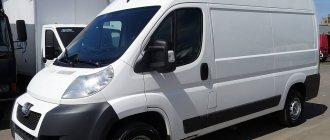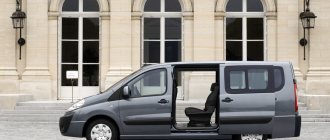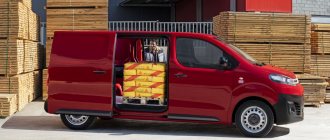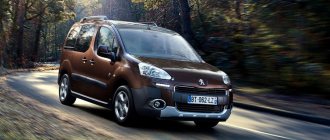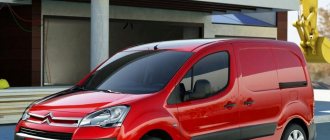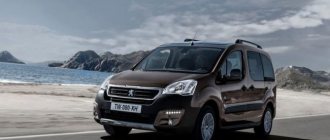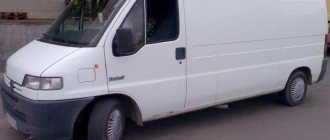...but without a third party. this can be called the first acquaintance with new representatives of light commercial vehicles on the completely new EMP2 platform from the alliance of PSA Groupe and Toyota Motor Europe, namely Citroen Jumpy and Peugeot Expert. Toyota practically does not promote commercial vehicles on the Russian market, at least until now. So about two from the casket
Sergey Zhukov
Citroen Jumpy L2H1 2.0 HDI AT6 / Peugeot Expert L3H1 2.0 HDI AT6. Gross weight: up to 3100 kg. Start of sales: July 2022 Price: from RUB 1,299,900
I’ll note right away that testing the new cars was a little unusual. Firstly, for acquaintance, they were not provided with extremely stuffed samples, but rather utilitarian vans for performing daily routine work. Secondly, after a test drive, cars should immediately go to alterators to familiarize themselves with the design and possible ways to transform them to create special configurations based on them.
Otherwise, we would have to wait more than two months before the arrival of the first “sales” cars in tolerable configurations. At a time when the LCV market has been on the rise for more than six months, marketers simply could not afford such luxury while waiting for new cars. That is why such an unusual event was born.
The test drive itself took place in three countries at once. We started from Moscow, then passed through Belarus, and the final point of our route was Vilnius. In general, there was more than enough time for everyone to communicate with the equipment, mileage and various driving conditions.
HISTORY OF THE ISSUE
For the first time, the vans of the PSA group - Citroen Jumpy and Peugeot Expert - saw the light of day in 1995. True, then the alliance looked somewhat different - PSA Groupe and Fiat Auto (Fiat Scudo). Today we can already see the third generation of LCV data. As for Toyota Motor Europe (Toyota Proace), it signed an agreement with PSA Groupe to share the existing platform and develop a new one in 2012. The agreement will be valid until 2022.
The loading height of the van is not satisfactory. If necessary, the rear hinged doors can be opened 180 degrees
In turn, Fiat Auto, at the time of the launch of the new platform at PSA in 2016, acquired a different strategic partner in the form of the Renault-Nissan alliance.
Citroen Jumpy and Peugeot Expert are produced in France, at the group's plant called SEVEL Nord (in Valenciennes). To this day, about 600 thousand copies of the Citroen Jumpy alone have been produced.
In Russia, the previous generation of these cars began to be sold at the end of 2013 as both passenger and commercial vehicles.
As already noted, the current generation is created on the EMP2 platform. Passenger and commercial vehicles are produced under different names. This was emphasized by the fact that the presentations of new models were spaced out over time. In February 2016, passenger models were shown for the first time at the Geneva Motor Show - Citroen SpaceTourer and Peugeot Traveler, and in the fall of the same year in Hannover - Citroen Jumpy and Peugeot Expert.
The machines feature a modern design. Citroen is made in a traditional manner - all slightly rounded, Peugeot - with a bit of aggression. Commercial versions are primarily distinguished by unpainted bumpers and side moldings.
THEY HAVE
Since we are mostly interested in commercial vehicles, we will tell you more about them. Let's start with the European versions available in foreign markets.
The information content of the dashboard is sufficient. However, you need to constantly monitor its brightness depending on the lighting
So, technical characteristics and platform EMP2. That is, Citroen Jumpy and Peugeot Expert vans. In fact, in addition to vans with two possible wheelbases and three lengths (due to an increase in the rear overhang) with a useful volume from 4.6 to 6.6 m3, vans with a double cab (up to 6 people and up to 5) are available in Western Europe .5 m3), a chassis for installing various add-ons and the so-called Combi, in other words, either a minivan or a minibus, with a capacity of up to 9 people including the driver. In passing, we note that the difference in the initial cost, for example, of a passenger Citroen SpaceTourer and a commercial Citroen Jumpy Combi on the German market reaches about 6,000 euros.
It makes no sense to focus on the engines, since these are Euro 6 diesel engines: 1.6 BlueHDi 95/115 with a power of 95 and 116 hp, respectively. With. and 2.0 BlueHDi 120/150/180 - 122, 150 and 177 liters. With. Less powerful engines are combined with manual 5- and 6-speed gearboxes, as well as a 6-speed “robot”, two-liter ones - with a 6-speed “mechanics” or a 6-speed automatic.
The engine is located deep down in the engine compartment. It's so easy to get close to something
By the way, the new version of the modular platform made it possible to reduce the weight of the vehicle by 100–150 kg (depending on the version) compared to the previous generation and integrate economical diesel engines - the combination of these factors provides one of the best fuel consumption figures in its class with a 2.0-liter engine. 0 liter. In addition to everything, the new platform favorably distinguishes the new product from its predecessor in such an indicator as the ratio of the wheelbase and the proposed useful volume.
Finally, the new LCVs from the PSA group received the maximum score in the Euro NCAP rating - 5 stars. This result was a well-deserved reward for the work done by the group.
The short length of the “banquette” pillow is clearly visible; you won’t sit on it for long
WE HAVE
Both companies will offer practically the same set on the Russian market, for now in vans, but... There will be a certain targeting. Thus, Citroen models will primarily be aimed at individual use, while Peugeot's priority is business.
Among the advantages, it should be noted the presence of a large number of shelves, trays and pockets for personal belongings. The “puck” for selecting automatic modes looks a little unusual. Periodically she reminded of her existence
As already mentioned, commercial vehicles under the two brands will have two wheelbases (2925 and 3275 mm) and three lengths (4606, 4956 and 5308 mm - slight differences are possible, each has its own body kit). In this regard, possible variations in useful volume: from 4.6 to 6.6 m3.
Vehicle heights range from 1940 to 1950 mm (suspension settings). The length of the cargo compartment is from 2162 to 4024 mm, the width between the wheel arches is 1258 mm. Depending on the design, 2 or 3 Euro pallets can be placed in the belly of the vans.
A small innovation in the full masses. The maximum possible design for total weight corresponds to 3100 kg. However, to circumvent the current restrictions, options with a gross weight not exceeding 2500 kg will be provided.
There are only two engines, both Euro-5: 1.6 HDi with 90 hp. s., which is combined with a manual 5-speed gearbox, and 2.0 HDi with a power of 150 hp. pp., coupled with either a 6-speed manual gearbox or a 6-speed automatic transmission. Crankcase protection is standard equipment.
If you have a second full seat, you can go on a long trip without any problems
Next comes a certain “gentlemanly” set of options (each brand has its own, you can feel the orientation). In any case, it is well-thought-out ergonomics, versatility, safety and ease of use. The high, comfortable seating position provides improved visibility. The convenient location of the dashboard allows the driver to control various functions without being distracted from the road. The seat upholstery is made of high-strength materials that guarantee not only durability, but also comfort.
The vehicles are adapted for Russia and meet the most diverse needs of customers depending on their field of activity (manufacturing, construction industry, logistics, service and municipal companies, etc.). There is a reinforced McPherson front suspension with anti-roll bar, variable springs and adaptive shock absorbers. This ensures maximum comfort when operating both an empty and loaded vehicle. The rear independent wishbone suspension also contributes to excellent handling and comfort, regardless of vehicle load and road conditions.
The congestion of the steering column switches is clearly visible
Just a few words about the possibilities. In addition to the standard solid steel partition, a Moduwork partition and modular design of the outboard passenger seats that fold into a flat floor are offered. The Moduwork partition, equipped with a mesh on the driver's side that prevents cargo from shifting, coupled with convertible seats, increases the loading capacity by 1.5 m3. A hatch under the passenger seat (optional) allows you to transport long items, and a folding passenger seat provides an increase of 0.7 m3 of useful volume.
What's more, the new vans can be transformed into a mobile office thanks to an optional swivel folding table with anti-slip surface.
Getting to the brake fluid reservoir is not so easy
The cargo compartment can be equipped with a protective floor covering and load securing devices (optional, factory installed). At the special request of the client, lining of the interior panels of the cargo compartment can be installed, up to the protection of the wheel arches.
There is also a towing kit that includes a switch box. It allows you to tow trailers with a total weight of up to 2.5 tons.
The Moduwork protective partition allows you to increase the usable space to 6.6 m3. There are also loops for securing cargo.
Moving into the driver's compartment, one finds numerous storage compartments distributed throughout the cabin: the lower glove box is equipped with a 12V power outlet and a USB port; a large storage compartment under the passenger seat, suitable for work boots and a safety helmet, for example; cup holder on both sides of the dashboard; a storage compartment in the center of the car and two slip pockets in the front door panels, capable of holding a 1.5 liter bottle.
The driver also has at his disposal a system for selecting a stabilization mode (road surface) Grip Control - extremely popular in difficult road conditions, a rain and light sensor, a blind spot indicator, parking sensors and a rear view camera, ABS + AFU, ESC + ASR, speed limiter and cruise -control, dynamic stabilization systems, Webasto programmable heater with remote control. Of course, not everything is included in the basic package, but, nevertheless, it is all available for order.
CITROEN JUMPY
Van in the L2H1 version with a 2.0 HDi engine with a power of 150 hp. With. mated to a 6-speed automatic transmission. The cargo compartment, without floor covering, is partially lined with plywood panels. One side sliding door plus double rear hinged doors with 180° opening angle. The driver's cabin was separated from the cargo compartment by a blank steel partition.
The driver’s rather simple workplace was pleased with the presence of climate control. Against this background, the automatic transmission with paddle shifters for manual gear shifting looked somehow ridiculous. Although it is still impossible not to note the presence of servo drives for power windows, adjustment of rearview mirrors and cruise control.
Having sat comfortably in the driver’s seat, I quickly managed to achieve the desired position. There are more than enough adjustments. In addition, the chair itself turned out to be comfortable. The same cannot be said about the double “banquette” for passengers. Not only does the airbag have too short a length, but one of the seat belt buckles constantly tries to hit the butt.
Other negative aspects include the rearview mirrors, which have a dead zone that is too large for a commercial vehicle.
I was pleased with the car with its throttle response. A combination of a two-liter diesel engine and an automatic transmission evokes the most blissful impressions. Cruise control deserves the same rating. By managing the latter competently, on the track you can avoid touching the pedals with your feet at all. I was pleasantly surprised by the maneuverability of the car. In the narrow streets of Vilnius she showed her best side.
Finally, looking under the hood, we immediately realized that there was nothing to do here without branded service. The engine is located deep below. Any manipulation requires either special tools or a lift with sub-assembly. You only had to look at the brake fluid reservoir to realize that this applies to almost everything. By the way, the location of the air filter also raised a lot of questions, especially its operation in the autumn-winter period.
Dimensions
Citroen offers an all-metal van in three lengths and one height without load: L - 4959, 5135, 5309 / H - 1920.
Citroen Jumpy
Peugeot, in turn, offers three length options and three unloaded height options: L - 4609, 4959, 5309 / H - 1950, 1940 and 1948.
Peugeot Expert
Visual part
Immediately we notice a complete redesign of the appearance, there are no separately changed parts, everything is new. The front is distinguished by convex shapes, imparting muscularity. Large head optics are installed, optionally with xenon filling and diode dimensions. The massive bumper is not painted in body color and is complemented at the bottom with round fog lamps.
From the side, especially at the front, the large wheel arch extensions formed by the bumper stand out. Rear arch Citroen Jumper (2) of smaller dimensions. You can highlight the deep depressed line in the center and the wide black molding between the arches.
At the rear, the power is emphasized by vertical headlights. The shapes are mostly straight. The bumper is made with a flat platform for easy loading of things into the luggage compartment. There are two doors here, first you need to open one using a massive handle, then open the second door from the side with another handle. The locks are locked via a button in the cabin. Doors open 180 degrees, or 270 for an additional fee.
Capacity
The useful loading volume of the Citroen ranges from 4.6 to 6.1 m3. Load capacity ranges from 600 kg to 1200 kg.
Citroen Jumpy
With the Moduwork , Peugeot has between 5.1 and 6.6 m3 of usable volume. The car can transform the interior, opening an opening between the luggage compartment and the cabin for loading long cargo. And thanks to the folding front seat, an additional 0.5 cubic meters is released. m. of free space in the cabin. Maximum payload from 585 to 1218 kg.
Peugeot Expert
Both vehicles can accommodate up to 3 Euro pallets. The total weight of the vehicles is equally 2.5-3 tons.
What's inside?
The cargo compartments of the cars have not undergone any changes - not surprising, since this pair has held the leadership in volume in its class for several years. This figure varies depending on the selected modification of commercial vehicles, but the maximum value for Peugeot Boxer and FIAT Ducato is 17 cubic meters. The height of the compartment can reach 217 cm and the width - 187 cm, which makes it possible to place fairly large cargo inside. The permissible load has not changed - it also varies in different modifications and can be up to 1.5 tons.
The interior of Peugeot and Fiat has been updated exclusively cosmetically - no significant differences in its structure from the previous generation are observed. However, we cannot talk about a complete absence of changes - the first new element that catches your eye is the multimedia complex on the center console. It has a display with a diagonal of 5 inches. A similar screen on the Ducato and Boxer is designed to control multimedia, view images from the rear camera, and also use navigation maps.
Many useful innovations have appeared in the interior of the Peugeot Boxer
In addition, a box has been added to the interior of the Boxer and Ducato, which can easily accommodate a 15-inch diagonal laptop, as well as a folder with documents and delivery notes. These papers can also be placed on a special tablet equipped with a clamp, however, a very large force is required to pull it out. Finally, a USB port has appeared for connecting external devices, but its location is completely inconvenient - it is located under the console, and you will have to look for it in the dark with a flashlight. The seat fabric on the new Peugeot Boxer and FIAT Ducato is wear-resistant, which extends the life of the interior trim.
The interior equipment of the FIAT Ducato allows the driver to feel comfortable on a long trip
Fuel consumption and maneuverability
Both cars are made on the EMP2 platform. The new versions managed to reduce the weight of the cars compared to the previous generation. Citroen Jumpy and Peugeot Expert are presented in a diesel engine version.
The ground clearance of Jumpy and Expert is 175 mm. Turning radius - 6.2 m.
Fuel consumption in the combined cycle of the Citroen Jumpy is 6 liters per 100 kilometers.
Fuel consumption in the combined cycle of the Peugeot Expert is 5.9 - 6 liters per 100 kilometers.
Here Peugeot Expert and Citroen Jumpy go head to head.
Engines and transmission Peugeot Expert
In Russia, compact Peugeot Expert vans are offered with two diesel engine options, both with turbocharging. The first of them has a displacement of 1.6 liters and a power of 90 hp. (66 kW), at 4000 rpm. The more powerful version of the engine has 2 liters of displacement and 150 horsepower (110 kW) at 4000 rpm.
If the choice is made on such a more powerful motor, then some additional possibilities appear. In particular, the ability to take a car with both a manual and an automatic gearbox. In both cases there will be six transmissions. As for the initial engine, there are no options for it - only a five-speed manual transmission is offered. The maximum torque is: 215 N.m, or 370 N.m at 2000 rpm.
The timing mechanism is driven by a toothed belt (in the initial configuration) or combined: roller chain + toothed belt (in more advanced configurations).
Features of Peugeot Expert engines: MHI turbocharger, Garett VGT with fixed charging geometry, intercooler, Common Rail electronic injection system, cylinder block made of alloy cast iron, with internal piston cooling with oil (for increased reliability at high loads), preparation for operation at extremely low temperatures and on diesel fuel of poor quality, a volumetric oil stop device (to prevent a “dry” start).
Thus, the gearbox options are as follows: five- or six-speed manual; Drive options: front-wheel drive and all-wheel drive 4x4.
Safety
Citroen Jumpy is equipped with a wide range of technologies for safety while driving:
- System for safe start of movement on an incline;
- Cruise control, speed limit system;
- Tire pressure monitoring system;
- Control system for crossing road marking lines.
Citroen Jumpy
Jumpy is also equipped with a touch screen, which displays information from the rear view camera.
Peugeot Expert is also equipped with an active and passive safety system:
- Trajectory control system - EPS;
- Anti-lock braking system - ABS;
- Cruise control;
- Engine heating, injector heating;
- Multimedia system, rear view camera, rain and light sensor.
Peugeot Expert
The cars are also equally equipped in these parameters.
Help from everywhere
In the wake of the general development of security systems, partner companies have also made efforts. At the same time, there is no point in arguing which is better - Boxer or Ducato - both will receive the same set of electronics, as well as the ability to order additional optional devices. In particular, all drivers will benefit from the updated ESP exchange rate stability system, which adapts to load. In both Fiat and Peugeot it will no longer be possible to completely deactivate the traction control device - it will turn on automatically if necessary.
Test drive a Peugeot Boxer:
It is also necessary to note the presence of an automatic assistant during long descents - it maintains a constant speed by regulating the pressure in the brake system. However, you should be careful - the device turns off automatically at a speed of 30 km/h and above. Fiat and Peugeot buyers will also have access to:
- Marking tracking system.
- Light sensor with automatic switching of headlight operating modes.
- Speed limiter.
- Cruise control.
Test drive a FIAT Ducato:
Comfort
If we look into the driver's compartment, we will see that both models have tolerable simplicity and ergonomics. Jumpy has a very comfortable driver's seat with all the necessary adjustments. Passenger seats do not differ in level of comfort. The Expert's driver's seat is also comfortable, however, the dashboard seems more modern. Both cars have excellent ergonomics and a good high driving position, combined with a wide view.
Peugeot Expert interior
In Citroen, the driver and passenger cabin are separated from the luggage compartment by a solid partition, while in Peugeot the dividing wall is thinner, which accordingly reduces noise insulation in the cabin. But the automaker Peugeot has provided the possibility of transporting cargo up to 4 meters long in the cabin, due to a special window in the partition.
In this comparison we give the same rating to the models.
Citroen Jumpy/Peugeot Expert/Fiat Scudo: “Van 2008” and more…
NEWS - USED CARS
On the one hand, in the sector of small commercial vehicles, everything is decided by the “money”: the car must earn money, and how it looks and drives is the tenth thing... On the other hand, there are plenty of “private owners” among buyers, so both the design and the level of comfort are important, and equipment positions, etc. Alas, as a rule, few people succeed in combining all this in one car, while ensuring an acceptable price. However, Citroen Jumpy, also known as Peugeot Expert, also known as Fiat Scudo, is a pleasant exception to the rule. It’s not for nothing that it was recognized as the “Best International Van of 2008”!
The second generation Citroen Jumpy/Peugeot Expert/Fiat Scudo debuted in 2007. The French did not offer anything particularly outstanding in cooperation this time: in fact, the same set of modifications remained in the range, only in a new generation. Standard or long wheelbase, regular or high roof, vans and passenger modifications - in general, everything is about the same as what we saw in the first generation. Only a little better: prettier, more convenient, more comfortable.
First of all, owners and truck drivers will certainly be pleased with the driving position. The second generation in this sense is many times better than the first: you sit lower, the ergonomic “triangle” is almost perfect, the seat is also better. Minuses? The first is sound insulation, which is sorely lacking, especially for those who have moved from a passenger car: pebbles in the arches, the sound of the engine, the rumble of the suspension - you hear not just sounds, but their echo. The second is control of the front clearance and visibility in general: it’s easier to install parking sensors in a circle than to suffer every time in courtyards and parking lots.
The interior can be praised: it is very large, the seats are simple but comfortable, there is a lot of space in both width and length. But there are also shortcomings. For example, the right seat in the middle row does not recline forward to make it easier to get into the third row - its back simply tilts. And if the car is regularly used to transport passengers, this need to squeeze into a narrow opening quickly becomes annoying...
The basic 1.6-liter HDI scares off many: they say, the car is big, the engine is small - all this is not serious... In fact, if you do not have a van, loaded to capacity every day, and not a minibus, 90 “horses” is quite enough. True, only for the city - thanks to the “short” gears. But on the track you won’t be able to get away with it: the windage is high, and the power is already low...
By nature, Jumpy and its brothers are “correct”, but still vans. In the sense that you seem to be sitting in almost a passenger car, but at the same time it drives more like a commercial vehicle: there is not enough sound insulation, and the smooth ride of an unloaded car is not amazing. But if you compare not with cars, but with small commercial vehicles, then the complaints immediately disappear: Jumpy & Co are truly the best in their segment. Or at least they certainly were in 2008...
Pavel KOZLOVSKY ABW.BY
Who's against it?
The popularity of minibuses in our country is undeniable. But the VW T4, due to its age, is already “running out” or costs ridiculous amounts of money, and its successor, the VW T5, has long ceased to be an icon of reliability and maintainability. The quality of products from global automakers is approximately at the same level, and if you can’t see the difference, why pay more? Perhaps it’s worth looking among cheaper cars, such as the latest generation Citroën Jumpy/Fiat Scudo/Peugeot Expert?
Motors of the HDI family have long and firmly taken their place under the Belarusian sun. On the Citroen Jumpy, the heavy fuel engine is, in fact, the main one: even in the German aftermarket there are two-liter gasoline versions with a power of 140 hp. almost never occur. Therefore, you will have to choose from a 1.6-liter 90-horsepower and a two-liter with a power of 118 to 136 hp. Experts from the German Autobild note turbines and exhaust gas recirculation system valves as the weak points of these diesel engines. Some owners note that after driving more than 100 thousand km, a burning smell begins to be felt in the cabin, and a knocking sound appears in the engine. “The issue can be resolved by replacing the fireproof copper washers installed under the nozzles,” one of the participants in the specialized forum shares his experience.
The weak point in the front suspension is the ball joints and anti-roll bar struts, which had to be replaced almost every 20 thousand kilometers. It should be noted that the ball joints are assembled with the lever, and the stabilizer rubber bands are changed along with the stabilizer itself. However, some workshops are already engaged in restoring the ball joints, as well as the steering rack, which can withstand 250 thousand km, and the rubber bands are successfully cut off, after which they are replaced with new ones from a different model. Garage service, of course, is harsh, but these are the realities of repairing out-of-warranty cars.
Opinion of the owner of Peugeot Expert Tepee (analogue of Citroen Jumpy) 1.6 HDI, 2008 model year, declared mileage 136 thousand km:
— I really like the engine. I thought that it would not be enough for such a large car, but it really does. And most importantly, during my ownership it never let me down. True, I have never been serviced by a dealer; I have my own approach to purchasing “consumables”: for example, I never use an oil filter from Purflux, because I don’t trust it. There were cases when all the fuel “died” because of it - its degree of purification was insufficient. At first the front suspension of my Peugeot let me down, I changed the ball joints like seeds. But then I bought spare parts from another manufacturer and have now driven almost 50 thousand on them - so far everything is quiet. The car is far from new, the mileage is decent - the side door began to play a lot. I don’t believe in fairy tales about something that might fall off, but it will have to be repaired. Perhaps I could also improve the assembly and fitting of materials - the car seems to be designed only for smooth German autobahns. Otherwise, everything suits me, and what captivates me first of all is the low price...
French cars may not have the best reputation, but the issue of price decides a lot: Citroen Jumpy in a similar configuration is 25-30% cheaper than the same VW T5. Well, before purchasing, we can only recommend additionally checking the engine and front suspension.
Alexey KHVOSHCHINSKY ABW.BY
Reliability Weak front suspension. Problematic turbine.
Pros: Good ergonomics. Spacious salon.
Our opinion Strictly speaking, since the choice is small and there are practically no truly reliable “used” cars left in any class, it makes sense to choose the “lesser evil” - something that does not break down too often and is not very expensive to repair. That is, Citroen Jumpy or its brothers. Not the most scary on the outside, comfortable on the inside, simple and not very capricious... In general, you can take it!
View full news
Modifications
The buyer is offered different versions of the body, slightly different in appearance. The most popular is the Citroen Jumper van (Van) and minibus with up to 22 seats. These modifications differ visually in their glazing; the passenger version has a larger glazing area. The van is completely metal.
Occasionally there are chassis that eliminate the presence of a rear body. The chassis allows you to install a manufactured goods van, an isothermal van, an onboard platform with or without an awning at the factory or independently.
The length of the truck differs, and as a result, the carrying capacity is different - from 1 to 2 tons of cargo. In running order, the weight of the car again varies from 1920 to 2260 kilograms.
Van dimensions:
- length – 4963-6363 mm;
- width – 2050 mm;
- height – 2254-2764 mm;
- wheelbase – 3000-4035 mm;
- ground clearance - 176 mm.
The length of the minibus starts from 3963 mm and reaches the same parameters as a van.
Malfunctions
The car is reliable, as any owner will tell you, but this does not change the fact that problems occur at high mileage. There is no such thing as eternal.
By 200 thousand kilometers the chain stretches greatly, and closer to 300 thousand it breaks. Because of this, the piston receives a powerful blow. Here, depending on your luck, the valves may not be bent, then you will get away with replacing the rockers and the chain itself. It is better to change the chain with the entire set at 180 thousand.
The second most common malfunction of the second generation Citroen Jumper is hardly a breakdown. Many mechanics set the timing according to the hour indicator, but this is not worth doing here. Because of this, the first piston does not move fully, resulting in a decrease in compression and power.
The paintwork is treated with PSA technology, but this does not help the body. Three years after the purchase, “saffron milk caps” are already appearing.
Minor breakdowns always occur, but in these internal combustion engines it is necessary to fix everything at once, because each breakdown leads to others.
Price
The second generation has been discontinued, so it’s worth considering aftermarket offers. The average price on message boards is 600,000 rubles , it all depends on the mileage, year of manufacture and modification. At the time of production, the base cost started at 1.6 million rubles.
Conclusion: Citroen Jumper 2nd generation is an excellent commercial vehicle, it’s not for nothing that it has sold in huge quantities throughout the Russian market. You can also buy it now; for 600 thousand you will get a reliable, comfortable car. Spare parts are cheap, the design is simple. Analogs are assembled with this model at the same factory, so you can take a closer look at them, there is no difference.


